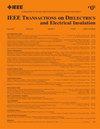Aging Characteristics of Ceramifiable Silicone Rubber Nanocomposites Exposed to Electrolytic Solution
IF 3.1
3区 工程技术
Q2 ENGINEERING, ELECTRICAL & ELECTRONIC
IEEE Transactions on Dielectrics and Electrical Insulation
Pub Date : 2025-03-06
DOI:10.1109/TDEI.2025.3548973
引用次数: 0
Abstract
The capability to transform into a flame-retardant ceramic body when encountering high temperatures makes low melting glass (LMG) powder an effective additive for room temperature vulcanized (RTV) silicone rubber composites, which are used as coating materials for outdoor high-voltage insulators operating in harsh environments. In this context, the present study examines the impact of nano LMG powder (LMGP) on the aging characteristics of 5 wt% boron nitride (BN)-doped silicone rubber nanocomposites exposed to a strong electrolytic aqueous ammonium chloride (NH4Cl) solution. LMG nanofiller was added in varying weight percentages of 3 and 7 wt%. Except for the 7 wt% LMG-doped composite, a distinct dip in weight gain, indicating higher degradation and detachment of filler particles, was noted in all the composites during diffusion test. Aging-induced deterioration of surface morphology is well evident in 3-D microscopy, contact angle, and Fourier transform infrared (FTIR) spectroscopic test results, which clearly demonstrate increased surface roughness and scissioning of side chains (Si-CH陶瓷硅橡胶纳米复合材料在电解溶液中的老化特性
低温玻璃(LMG)粉末在高温下可以转化为阻燃陶瓷体,这使得它成为室温硫化(RTV)硅橡胶复合材料的有效添加剂,用于在恶劣环境下工作的室外高压绝缘子的涂层材料。在此背景下,本研究考察了纳米LMG粉末(LMGP)对5wt %氮化硼(BN)掺杂硅橡胶纳米复合材料暴露于强电解氯化铵(NH4Cl)溶液中的老化特性的影响。以3 wt%和7 wt%的不同重量百分比加入LMG纳米填料。除了掺杂7wt % lmg的复合材料外,在扩散测试中,所有复合材料的重量增加都有明显的下降,这表明填料颗粒的降解和脱离程度更高。在三维显微镜、接触角和傅里叶变换红外(FTIR)光谱测试结果中,老化引起的表面形貌恶化非常明显,这清楚地表明,所有复合材料的表面粗糙度增加,硅橡胶基体中的侧链(Si-CH $_{{3}}\text{)}$和主链(Si-O-Si)断裂。此外,通过斜面跟踪和侵蚀试验、热重分析(TGA)和红外热像仪对所有试样的抗污染性能和热性能进行了评价。实验结果表明,与单纯的BN试样相比,掺杂lmg的复合材料具有更好的跟踪和耐蚀性,更高的热稳定性和更低的表面温度分布。实验结果表明,7 wt% LMG复合材料具有较好的抗NH4Cl溶液降解性能。
本文章由计算机程序翻译,如有差异,请以英文原文为准。
求助全文
约1分钟内获得全文
求助全文
来源期刊
CiteScore
6.00
自引率
22.60%
发文量
309
审稿时长
5.2 months
期刊介绍:
Topics that are concerned with dielectric phenomena and measurements, with development and characterization of gaseous, vacuum, liquid and solid electrical insulating materials and systems; and with utilization of these materials in circuits and systems under condition of use.

 求助内容:
求助内容: 应助结果提醒方式:
应助结果提醒方式:


